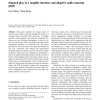Free Online Productivity Tools
i2Speak
i2Symbol
i2OCR
iTex2Img
iWeb2Print
iWeb2Shot
i2Type
iPdf2Split
iPdf2Merge
i2Bopomofo
i2Arabic
i2Style
i2Image
i2PDF
iLatex2Rtf
Sci2ools
PUC
2007
2007
Situated play in a tangible interface and adaptive audio museum guide
This paper explores the design issues of situated play within a museum through the study of a museum guide prototype that integrates a tangible interface, audio display, and adaptive modeling. We discuss our use of design ethnography in order to situate our interaction and to investigate the liminal and engagement qualities of a museum visit. The paper provides an overview of our case study and analysis of our user evaluation. We discuss the implications including degrees of balance in the experience design of play in interaction; the challenge in developing a discovery-based information model, and the need for a better understanding of the contextual aspects of tangible user interfaces (TUIs). We conclude that learning effectiveness and functionality can be balanced productively with playful interaction through an adaptive audio and TUI if designers balance the engagement between play and the environment, and the space between imagination and interpretation that links the audio conten...
| Added | 27 Dec 2010 |
| Updated | 27 Dec 2010 |
| Type | Journal |
| Year | 2007 |
| Where | PUC |
| Authors | Ron Wakkary, Marek Hatala |
Comments (0)

